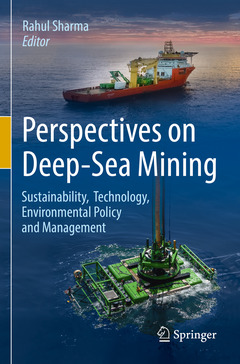Description
Perspectives on Deep-Sea Mining, 1st ed. 2022
Sustainability, Technology, Environmental Policy and Management
Coordinator: Sharma Rahul
Language: English
Subjects for Perspectives on Deep-Sea Mining:
Publication date: 01-2023
689 p. · 15.5x23.5 cm · Paperback
Publication date: 01-2022
689 p. · 15.5x23.5 cm · Hardback
Description
/li>Contents
/li>Biography
/li>Comment
/li>
This book is a sequel to ?Deep-Sea Mining: Resource Potential, Technical and Environmental Considerations? (2017) and ?Environmental Issues of Deep-Sea Mining: Impacts, Consequences and Policy Perspectives? (2019), and aims to provide a comprehensive volume on different perspectives of deep-sea mining from specialists around the world. The work is timely, as deep-sea minerals continue to enthuse researchers involved in activities such as ascertaining their potential as alternative sources for critical metals for green energy and other industrial applications, as well as technology development for their sustainable exploration and exploitation, while addressing environmental concerns. With a steady increase in the number of contractors having exclusive rights over large tracts of seafloor in the ?Area?, i.e. area beyond national jurisdictions, the International Seabed Authority, mandated with the responsibility of regulating such activities, is in the process of developing a code for exploitation of deep-sea minerals. These, coupled with growing interest among private entrepreneurs, investment companies and policy makers, underscore the need for updated information to be made available in one place on the subject of deep-sea mining. The book evaluates the potential and sustainability of mining for deep-sea minerals compared to other land-based deposits, the technologies needed for mining and processing of ores, the approach towards environmental monitoring and management, as well as the regulatory frameworks and legal challenges to manage deep-sea mining activities. The book is expected to serve as an important reference for all stakeholders including researchers, contractors, mining companies, regulators and NGOs involved in deep-sea mining.
Dr. Rahul Sharma retired as a Chief Scientist from the National Institute of Oceanography in Goa, India. He received his PhD in Marine Science from Goa University in 1997. His research interests include development of underwater photography for deep-sea exploration, environmental impact assessment for deep-sea mining, and application of exploration data for deep-sea mining and environmental conservation. He has undertaken several assignments for international research organizations, academic institutions and the International Seabed Authority. He is the editor of the books ‘Deep-sea mning (2017)’ and ‘Environmental issues of deep-sea mining (2019) published by Springer.
Provides an overall perspective of the evolution of different aspects of deep-sea mining
Evaluates the potential and sustainability of deep-sea mineral resources
Discusses regulatory frameworks and challenges to manage deep-sea mining activities




